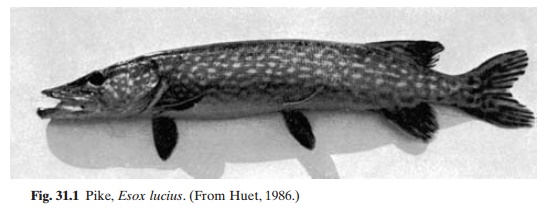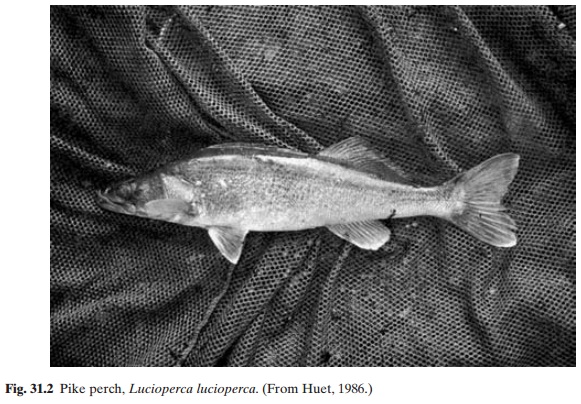Chapter: Aquaculture Principles and Practices: Stocking of Open Waters and Ranching
Lakes and streams - Open water stocking
Open-water stocking
Lakes and streams
The main characteristic of lakes and streams, in so far as stocking is
concerned, is that they have significant autochthonous populations of fish, and
stocking is generally intended to enhance the economically important ones or to
occupy ecological niches in the fauna. Unlike newly formed reservoirs, these
natural water bodies have more or less stabilized ecosystems and therefore call
for appropriate studies to determine the need and desirability for stocking.
Although there are several instances where natural lakes have been stocked and
managed along the same lines as reservoirs, as described above, it would appear
that the majority of enhancement programmes in lakes and streams have been for
establishing or augmenting sport fisheries.
The introduction of the rainbow and brown trout in streams in several
countries for sport fisheries has already been referred. In order to maintain
an adequate population of the species in the trout streams, hatcheries and
nursery farms are established in suitable sites with a plentiful supply of
clean water of the right temperature. The improvement of streams to ensure good
quality water and the production of the natural food of trouts and
implementation of the regulations regarding the size and number of fish that an
angler can catch are some of the management measures taken to maintain the
trout stocks. Though there are not many cases of established self-perpetuating
populations of trout outside their natural range of distribution, it has been
possible to maintain small populations through continued stocking of
hatchery-produced young in many streams. Exceptions are some of the rivers in
Canada and the Falkland Islands, where breeding populations have established.
Large-mouth bass, Micropterus
salmoides, is an important sport fish in the USA and among the management
measures adopted are regular stocking and balancing of its populations with
those of forage species. When forage species such as the black crappie (Pomoxis nigromaculatus) blue gill (Lepomis macrochirus)and golden shiners (Notemigonus crysoleucas) overcrowd a
lake, corrective restocking has to be undertaken.This involves the stocking of
fingerling large-mouth bass, following a marginal or sectional treatment with a
fish toxicant like rotenone or Fintrol-S. A stocking rate of 60–120 fingerlings
per ha is generally adopted. If over-crowding of black crappie or golden
shiners(which spawn before large-mouth bass) occur, ‘early spawned’ large-mouth
bass may be stocked at the rate of 125–250 per ha. An alternative management
measure, when the lakes show a trend towards a crowded forage condition or have
been heavily fished, is to stock large-mouth bass of 20–25cm length. The lakes
are closed to bass fishing for at least one month after stocking, as the
hatchery-reared bass are extremely susceptible to hook and line.
Generally an annual harvest quota is enforced on the basis of catch records
and population estimates. The introduction of additional forage species like
the threadfin shad, Dorosoma petense,
has very often resulted inincreased bass fishing in lakes deficient in forage
fish. The channel catfish (Ictalurus
punctatus) and sometimes the white catfish (I. catus)are stocked in the lakes as additional sport fish to take
some of the fishing pressure off large-mouth bass. They are usually stocked at
the rate of 250 per ha.
The pike Esox lucius is
another important game fish, especially in Europe (fig. 31.1), and its
artificial propagation is practised in a number of countries for stocking lakes
and other water bodies. Besides being a sport fish, the pike is considered to
be a valuable fish to reduce coarse fish populations in lakes, as it is a
voracious carnivore. Pikes spawn from February to the end of May, when the
water temperature is about 8–10°C. In nature they spawn in shallow grassy
waters. Brood fish can be caught from the neighbourhood of such areas, held in
special brood ponds and fed on coarse fish. In small sheltered ponds, supplied
with spring water of constant temperature, male and female pikes readily mature
and spawn. Normally a female spawns about 20000–25000 eggs per kg. Incubation
and hatching of eggs are generally carried out in large Zoug jars. Each jar
(60–70cm in height and 15–20cm diameter) will carry between 1 and 5l eggs.
Other types of hatchery jars can also be used. The best temperature for
hatching pike eggs is between 8 and 15°C. Artificial fertilization of pike eggs
can be carried out in more or less the same way as for salmonids. Pike eggs are
smaller in size (2.5–3mm in diameter) and more delicate and should be handled
with special care. The incubation period is about 120 degree-days. Just before
hatching, the embryos are removed to hatching trays similar

to those used for salmonids, but with holes less than 2mm in diameter.
The absorption of the yolk sac takes about 160–180 degree-days. When the yolk
sac is fully absorbed, the larvae are released into the lake.
It is reported that if postlarvae are stocked, a survival of ten per
cent can be expected. In order to minimize mortality after stocking, it is
preferable to stock fingerlings, as with all other species used for
repopulation. But the main problem is that pikes require live food from the
post-larval stage onwards and from the time they reach 6–10cm they are highly
carnivorous. Because of this, the fry are reared in troughs for three to four
weeks, fed on zooplankton collected from natural waters in sufficient
quantities to avoid cannibalistic tendencies. Troughs made of concrete or other
durable material can be stocked with up to 2500 larvae per m3 and will give about 60 per cent
survival. The fry are then transferred to rearing ponds and are harvested in
six to eight weeks, by the end of April. The rearing ponds are similar to carp
ponds. Sometimes carp ponds themselves are used for pike rearing in rotation
with carp. Under normal conditions, 10000–25000 fry are stocked per ha and the
average survival is about 20 per cent.
Pike perch is another important carnivorous fish of equal importance as
a sport fish and also as a food fish in Europe (fig. 31.2). They are
well-suited for stocking lakes and grow rapidly, reaching a weight of up to 1kg
in about three years. They spawn in the spring, when the temperature is
12–16°C. The male digs shallow nests on sandy or gravel beds in shallow areas.
Eggs are laid on roots of aquatic plants placedin the nest. A female weighing
about 1kg can lay about 200000 eggs, which stick to the substratum. The brood
fish watch over the fertilized eggs, which hatch after 8–10 days at
temperatures of 11–14°C.

Under culture conditions, selected brood fish are liberated in spawning
ponds (very often spawning ponds of carp are used) where artificial nests are
placed. These nests are made of wire netting on a wooden frame and attached to
it are small roots of willow, alder or water plants on which the fish can
deposit the eggs. Several designs of nests, in particular one with a canopy of
roots, have been used. Soon after the eggs are laid, the nests are transferred
to hatching ponds. Eyed eggs can be transported long distances. Fertilized eggs
can also be transferred to open waters in perforated hatching boxes, from which
the hatched larvae can escape directly into the lake. However, it is necessary
to grow them for a few weeks at least to obtain a higher survival rate. The
larvae should be reared in nursery ponds with a dense growth of zooplankton,
such as rotifers and cyclops. Fry of 15mm will eat insect larvae, plankton and
benthic fauna. In the absence of forage fish, they become cannibalistic at a
size of about 4cm. Since feeding them after this stage is difficult, they are
usually stocked in open waters at this point.
Besides pike and pike perch, species of coregonids, especially Coregonus albula and Coregonus lavaretus, are propagated on a limitedscale for stocking alpine oligotrophic lakes in Europe. The methods of propagation are very similar to those of pike. The brood fish are collected from the natural spawning grounds in the lake. Coregonus albula breeders may weigh between 30 and 200g, while C. lavaretus can vary from 1 to 3kg. A female of C. albula gives from 2000 to 10000 eggs and C. lavaratus 10000 to 19000 eggs per kg weight. Artificial fertilization is carried out in exactly the same way as for salmonids and the incubation is performed in Zoug or MacDonald jars. The eggs can be left to hatch in the jars and take between 300 and 360 degree-days, at a low hatching temperature of 5°C. The hatchlings measure only about 10mm in length and 1mm in diameter. Core-gonid fry have very small yolk sacs, which are rapidly absorbed in about three to five days after hatching. They are usually stocked soon after the yolk sacs are absorbed, and so the survival rate is low, between 1 and 10 per cent. It is not too clear whether such stocking operations are economically justifiable.
Though an anadromous species, the transplantation of ayu (Plecoglossus altivelis) as practised in
Japan is essentially a stocking operation, rather than ranching. No
reproduction is expected from the stocked fish as most surviving fish are
caught as adults by sport or commercial fishermen during the year of release.
This is largely because its entire life span, including the migration to the
sea and return, is completed within a year and the rate of recapture is very
high.
The construction of a series of dams across rivers has prevented the
upward migration of ayu and greatly reduced its living areas. This, along with
pollution, has resulted in a considerable decline in ayu populations. Being a
very popular object of river fishing and a highly priced food fish, continued
efforts have been made to resuscitate the stocks and maintain the catch at an
increasing level. This has been accomplished by regular stocking of fry.
According to one estimate, not less than 266 tons of fry are stocked in the
rivers. In the past, Lake Biwas was the main source of fry, but now fry from
the foreshore areas near the spawning grounds of the fish, and also fry from
the river when they start ascending, are caught for stocking.When stocked, the
lake form of fry gives the highest survival rate, the next best being the
river-run fry (those collected from the river). However, the collection of fry
from all thesesources are still not able to fulfil the increasing demand.
Techniques for artificial propagation and rearing of ayu fry have therefore
been developed and this is expected to help in meeting the increased demand,
including the requirements of pond culture of the species.
The sea-run fry have to be conditioned for several days to acclimatize
them for transfer to fresh water. This is done by holding them initially in
ponds filled with 1 part sea water to 4 parts fresh water, and after a day or
two transferring them to fresh water. They are held in fresh water for five to
seven days before ship-ment for release. The river and lake-run forms are also
held in fresh water for a time to empty their guts for transportation. Special
transport containers are used to transport the fry in water saturated with
oxygen. It is believed that a medicated bath during transport will result in
higher survival rates.
The rate of recapture after stocking varies widely (depending on the
nature of the river), ranging from 10 to 80 per cent, but usually between 40
and 60 per cent. In most rivers the fish reach lengths of 20–22cm about five
months after stocking.
Related Topics